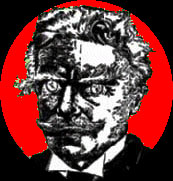|
by Don Swaim
________________
The field was too small for his genius," writes Gertrude Atherton of Ambrose Bierce in her 1932 memoir Adventures of a Novelist. At the time of their acquaintance, Bierce was a brilliant columnist for William Randolph Hearst's San Francisco Examiner. She writes, "Why he was never shot was one of the problems, for he spared no one, however eminent, who had a crack in his armor." Atherton says that whenever she and Bierce met they bristled at each other with antagonism, and that she never spent a pleasant hour in his company; however, she relishes the pages and pages of letters she received from him. "I must have had a hundred of those letters," she writes, "all expressed in a prose that made every sentence a treasure. And models of calligraphy; save my grandfather's I have never seen a more beautiful handwriting."
|
|
Atherton despairs that her entire archive of Bierce letters was destroyed in the San Francisco earthquake and fire of 1906. "Someone stole the copy of Soldiers and Civilians [Bierce's masterwork] he gave me, and the only memento I have of him is a photograph--autographed on the back!"
To the left is a sample of his handwriting, a letter by First Lieutenant A.G. Bierce, 9th Indiana Volunteers, dated January 10, 1865, Huntsville, Alabama, in which Bierce resigns his commission, thus ending his military career. His amazing handwriting is so straight, it's as if he'd used a guide of some sort to steer his hand across the page.
It reads:
"I have the honor hereby to tender my resignation, based upon the accompanying Surgeons Certificate. I am responsible to the Government for no property whatever, and there are no charges against me affecting my pay."
|
While his handwriting was superb, Bierce, like Mark Twain, eventually succumbed to the lure of the typewriter, which developed commercially in the 1870s. In fact, Twain wrote in a letter dated March 10, 1875: "Please do not divulge the fact that I own a machine. I have entirely stopped using the Type-Writer, for the reason that I never could write a letter with it to anybody without receiving a request by return mail that I would not only describe the machine but state what progress I had made in the use of it, etc., etc."
The first commercially successful "Type Writer" was marketed by Sholes & Glidden in 1874. A patent for the "QUERTY" keyboard design, still in use today, was granted to Christopher Latham Sholes in 1896.
Bierce it seems began writing on a typewriter as early as 1902.
In his 1929 "biography" of Bierce, Adolphe (Danziger) De Castro, a longtime acquaintance, cites Bierce's early attempts at using a typewriter. De Castro writes that on February 8, 1902, Bierce wrote to him "on a typewriter which showed his lack of expertness." Bierce's letter concludes: "That's all that is worth the torture that I am inflicting upon my unhappy typewriter, and upon myself in inflicting it, for I am far from proficient in the manipulation."
In a letter to De Castro dated February 18, 1902, Bierce writes, "I have written this in a race-horse speed -- overlook the erroneous typewriting."
While the eccentric De Castro is unreliable as a biographer -- particularly with regard to his claim that he was told personally by Pancho Villa that the Mexican had Bierce shot because, "We have no patience with traitors." -- there is no reason to believe the letters De Castro cites are not genuine.
Here's a sample of a typewritten letter to Walter Neale by Bierce dated April 11, 1911, with the sardonic conclusion, "May God overlook you."
 click to enlarge click to enlarge
Neale was a Washington, DC, publisher who was in the process of publishing Bierce's twelve-volume Collected Works. In his letter, Bierce quotes S.O. Howes, editor of Bierce's book of essays, The Shadow on the Dial, published by A.M. Robertson, San Francisco in 1909, relating to copyright issues. The essays were eventually re-published in Volume XI of Bierce's Collected Works. Bierce cites "Miss Christiansen" in his letter. Carrie Christiansen was Bierce's secretary and heir to his estate. Note that Bierce drops the word "The" just before "Collected edition" and writes it in by hand.
Kudos to Mr. Bierce for being an early adopter of the typewriter. No doubt that if he were living today, and after an appropriate amount of skepticism, he would enthusiastically be typing away at his Macintosh, Googling what's left of the Hearst empire, and happily emailing invective to friends and enemies alike.
________________
Sources cited: Atherton, GertrudeAdventures of a Novelist. Liveright, New York, 1932; Bierce, Ambrose, The Shadow on the Dial, A.M. Robertson, 1909; De Castro, Adolphe, Portrait of Ambrose Bierce, Century, 1929; Neale, Walter, Life of Ambrose Bierce, Walter Neale Publisher, 1929; Twain, Mark, "The First Writing-machines," 1875. Readprint.com.
© 2008 Don Swaim
|

